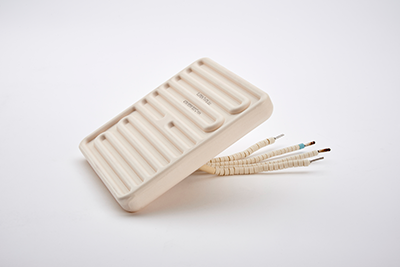Benefits of Ceramic IR Heaters

Our ceramic radiant heat panels are popular because they are much more efficient than standard heaters. Normally, heaters function by burning fuel to heat the air and then distributing this air throughout the area in question. This process is known as radiative heat transfer.
With ceramic IR heaters, up to 96% of the fossil fuel energy is directly transmitted to the target. This efficiency level means that our customers minimize wasted fuels, preserving valuable resources and cutting down their costs.
Because so little of the energy is wasted, IR heaters have minimal need for air removal, so first-time users do not need to worry about revamping their vent systems. This characteristic also means that IR heaters are quiet, allowing our customers to run them without increasing their ambient noise or annoying their employees.
Additionally, our heaters are customizable. For customers who need to hyperfocus their heat to cook food or manufacture a metal product, we offer concave heaters. For customers who want to heat their buildings or keep their storage areas from getting too cold, we have flat heaters.
Common Applications of Ceramic Heaters
Ceramic heaters are popular in industries that require constant low-level heat, including food dehydrating, plaster or plastic mold pre-heating and heating, and sanitary packaging. The automotive, information technology, and medical industries also depend on IR heating to warm their sensitive components carefully and steadily.
Many manufacturers choose our IR heaters for non-contact drying, or drying processes that happen quickly without disturbing the material being dried. Thermoforming, which involves stretching a thermoplastic sheet into a mold, is one process that relies on non-contact drying. Similarly, if a home renovation company needs to finish a job quickly, an IR heater can help a fresh coat of paint dry.
IR heaters are also indispensable to composite manufacturing. Composite, which is mostly used in the dental industry, must be warmed before installation in people’s dental replacements so that it does not shrink. Heating composite with IR heaters allows its dimethacrylate monomers to combine with its binding agents and glass fillers.
This step, which many dentists have skipped until recently, ensures that water does not sink into cracks in the composite and break it apart, necessitating another trip to the dentist.
Types of Ceramic IR Heaters
There are many different kinds of ceramic heaters. We offer different colors to help our customers understand their chosen model’s temperature ranges, and some models’ colors change when the nichrome wire or ceramic heating elements aren’t working properly. Ceramic heaters are also available in flat and concave shapes depending on the desired heat intensity.
The different shapes also affect each heater’s radiant emission patterns. Flat heaters have uniform heating patterns, which are most helpful when heating large areas such as recently finished walls or thermoplastic sheets.
Concave heaters have concentrated radiation patterns, delivering compressed radiation that is ideal for both radiant and zoned heating. The third shape, convex, creates wide radiant emissions, which are best for heating a large area such as an industrial oven or a storage facility.
Another way to tell ceramic heaters apart is by looking at their power sources. A gas-powered infrared heater, also known as a radiant gas heater, gets its fuel from oil, natural gas, and other fossil fuels. The combustion process happens within a ceramic or metal chamber, so there are still no open flames, and the resulting energy is emitted as infrared radiation rather than ordinary heat.
This type of heater has two subtypes: luminous (which is used in huge warehouses because of its power) and radiant tube (which relies on a metal tube and offers lower-level heating).
Electric ceramic infrared heaters are best for localized heating purposes. These heaters run electricity through a heating element made of nichrome, cupronickel, tungsten, or another alloy, and this process triggers the heater to give off infrared radiation. Most electric ceramic IR heaters must be plugged into outlets that produce 120 or 220 volts of electricity.
How To Choose a Ceramic Emitter
Choosing the right ceramic emitter starts with determining what you’re planning on heating. If you’re heating large, open spaces, flat ceramic emitters are the right choice. We also recommend this uniform style if you’re keeping food warm between preparing and serving it or if you are warming plastics with low melting points. Make sure that your chosen model operates within your desired temperature range, too.
If you want to heat a larger area but you still want the heat distributed well, our convex, wide-area heaters are good options. For the most concentrated heating applications, choose concave ceramic heaters. These heaters are perfect for installation in cooking ovens or manufacturing processes.
Industrial Electric Heaters
If you’re looking for clean and reliable heating sources, our ceramic infrared heaters are the perfect choice. Whether you need localized or distributed heat, consider adding one of our energy-efficient heaters to your manufacturing process today.
Speak with an expert
Over last 8 years we have addressed 95% of inside sales quoting requests within 3 hours.
